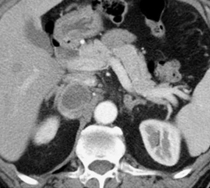Retroperitoneal Malignant Pheochromocytoma
Keywords:
RETROPERITONEALNEOPLASMS/surgery, PHEOCHROMOCYTOMA/diagnosis, PARAGANGLIOMA, CHROMAFFIN CELLS/ultrastructure, INTRAOPERATIVE COMPLICATIONS.Abstract
Introduction: the most common and best-known neoplasm of the adrenal medulla is benign pheochromocytoma, which can be defined as a paraganglioma of the adrenal medulla, which may secrete catecholamine of the types of norepinephrine, epinephrine, or both.
Clinical case: a 36-year-old, white race, female patient with a health history, assessed for a non-irradiated lumbar pain, which was spontaneously relieved, a blood pressure of 170/100 mm Hg at admission, the ultrasound reported the presence of a retroperitoneal tumor, the surgical exeresis of the tumor was performed, during the trans-operative stage the patient suffered from hemodynamic instability, hypotension, tachycardia and cardio-respiratory arrest, which was managed to her recovery. The patient dies in the first 6 hours as a consequence of a postoperative shock.
Conclusions: malignant pheochromocytoma constitutes only 10 % of these types of neoplasm, being an infrequent tumor in our environment; its report was significant to be presented. The diagnosis was made by histological study, considering malignant pheochromocytoma. A clinical case of adrenal malignant pheochromocytoma was reported, with the intention of contributing to the acquisition of a better management in relation to this type of neoplasm.Downloads
References
1. Guillín C, Bernabeua I, Rodríguez IA, Casanueva F. Feocromocitoma y paraganglioma. Medicine. [Internet]. 2016 [Citado 01/03/2018]; 12(14): [aprox. 6p.]. Disponible en: https://www.medicineonline.es/es-feocromocitoma-paraganglioma-articulo-S0304541216301032
2. Román González A. Nuevos conceptos en feocromocitoma y paraganglioma en el 2017. Revista Colombiana de Endocrinología, Diabetes y Metabolismo. [Internet]. 2017 Nov [Citado 01/03/2018]; 4(4): [aprox. 9p.]. Disponible en: http://revistaendocrino.org/index.php/rcedm/article/view/148
3. Perel C. Feocromocitoma. Insuf. card. [Internet]. 2014 Sep [Citado 01/03/2018]; 9(3): [aprox. 3p.]. Disponible en: http://www.scielo.org.ar/scielo.php?script=sci_arttext&pid=S1852-38622014000300004&lng=es
4. Díaz Díaz T, Fernández Rodríguez FM, Ruiz Criado J. Paciente con hipertensión y convulsiones. Revista Atalaya Medica. [Internet]. 2016 [Citado 01/03/2018]; (10): [aprox. 5p.]. Disponible en: http://atalayamedica.comteruel.org/index.php/revista/article/view/154/163
5. Mosquera Gorostidi A, Justo Ranera A, Zakirian Denis SE, González Temprano N, Sagaseta de Ilúrdoz Uranga M, Molina Garicano J. Feocromocitoma y paraganglioma en la infancia: a propósito de 2 casos. An Pediatr [Internet]. 2015 [Citado 22/09/2015]; 82(1): [aprox. 5p.]. Disponible en: http://www.elsevier.es/en/linksolver/ft/pii/S1695-4033(14)00333-6
6. Miranda Folch JJ, García Cuervo D, Vega Jiménez J, Alemán Marichal B, Jiménez
Álvarez A, Castelnau Sánchez A. Hipertensión arterial secundaria a
feocromocitoma esporádico. Presentación de caso. Rev Méd Electrón [Internet]. 2016 Ene-Feb [Citado 23/02/2018]; 38(1): [aprox. 10p.]. Disponible en: https://www.sciencedirect.com/science/article/pii/S0211699516300133
7. Uribe J, González MJ, Tamayo L. Manifestaciones inusuales del feocromocitoma. Reporte de caso y revisión de la literatura. Revista Colombiana de Cardiología [Internet] 2016 [citado 23/02/2018]; 23(2): [aprox. 18 p.] Disponible en: http://www.scielo.org.co/scielo.php?script=sci_arttext&pid=S0120-56332016000200013&lng=en&nrm=iso&tlng=es17-pdf
8. Cano Megías M, Rodriguez Puyol D, Fernández Rodríguez L, Sención Martínez GL, Martínez Miguel P. Feocromocitoma-paraganglioma: del diagnóstico bioquímico al genético. Nefrología. [Internet]. 2016 [Citado 01/03/2018]; 36(5): [aprox. 14p.]. Disponible en: https://www.sciencedirect.com/science/article/pii/S0211699516300133
9. Gómez Galán S, Mosquera Paz MS, Kadamani Abiyomaa A, Sánchez de Guzmán G. Paraganglioma retroperitoneal no funcional: reporte de un caso en la Fundación Cardioinfantil, Bogotá, Colombia. Iatreia [Internet]. 2014 Sep [Citado: 01/03/2018]; 27(3): [aprox. 3p.]. Disponible en: http://www.scielo.org.co/scielo.php?script=sci_arttext&pid=S0121-07932014000300010&lng=en
10. Molina M, Schiappacasse G, Labra A. Tumores que invaden la vena cava inferior: Revisión pictográfica de los principales hallazgos imagenológicos en tomografía computarizada y resonancia magnética. Rev. chil. radiol. [Internet]. 2016 [Citado 01/03/2018]; 22(1): [aprox. 14p.]. Disponible en: https://scielo.conicyt.cl/scielo.php?script=sci_arttext&pid=S0717-93082016000100010&lng=es

Downloads
Published
How to Cite
Issue
Section
License
Authors who have publications with this journal agree to the following terms: Authors will retain their copyrights and grant the journal the right of first publication of their work, which will be publication of their work, which will be simultaneously subject to the Creative Commons Attribution License (CC-BY-NC 4.0) that allows third parties to share the work as long as its author and first publication in this journal are indicated.
Authors may adopt other non-exclusive license agreements for distribution of the published version of the work (e.g.: deposit it in an institutional telematic archive or publish it in a volume). Likewise, and according to the recommendations of the Medical Sciences Editorial (ECIMED), authors must declare in each article their contribution according to the CRediT taxonomy (contributor roles). This taxonomy includes 14 roles, which can be used to represent the tasks typically performed by contributors in scientific academic production. It should be consulted in monograph) whenever initial publication in this journal is indicated. Authors are allowed and encouraged to disseminate their work through the Internet (e.g., in institutional telematic archives or on their web page) before and during the submission process, which may produce interesting exchanges and increase citations of the published work. (See The effect of open access). https://casrai.org/credit/


